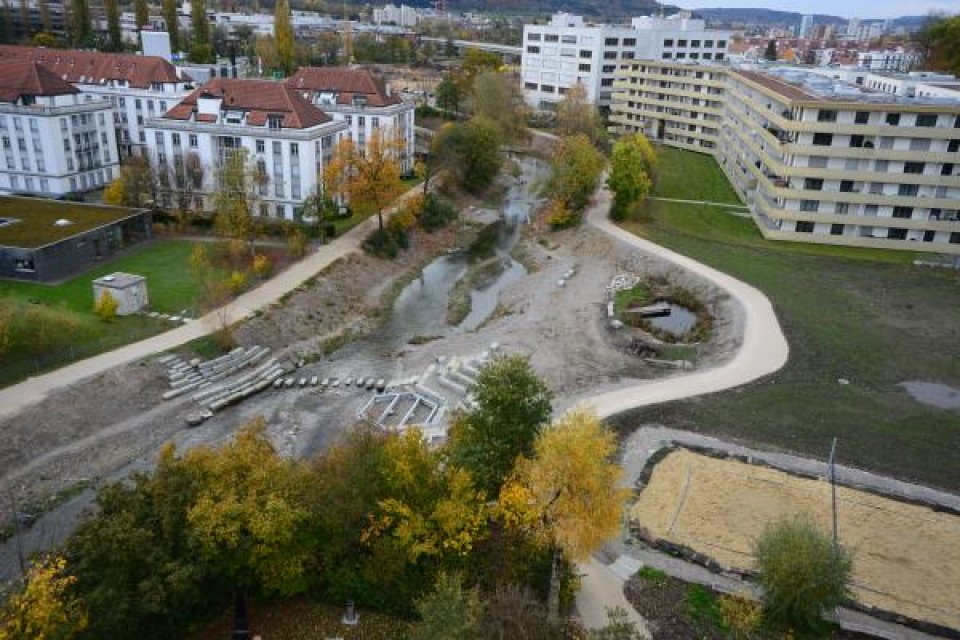
The Case Study is based in the densely populated Swiss plateau, an area of ca 11.000 km2, where ecological status and biodiversity have been decreasing over the past. Throughout Europe, rivers have been heavily modified to increase ecosystem services, such as flood protection, agricultural or hydropower production. These modifications include the construction of weirs and dams, channelization and modifications of floodplains for agricultural and urban use. This has led to morphological river degradation, reduction in lateral and longitudinal connectivity, to modified flow regimes and water pollution, but also to a loss of biodiversity and habitats, as well as a decrease of other ecosystem services such as recreational and aesthetic value. So far, efforts to rehabilitate river sections, reduce negative effects of hydropower plants, improve water quality by constructing waste water treatment plants and decreasing pollution from agriculture have shown many positive local effects. These improvements, however, were not yet able to revert the trends of declining biodiversity and habitat loss in Swiss rivers. The Case Study considers whether water management could be improved to lead to larger positive effects on biodiversity and habitats, given the same budget and without a considerable loss of ecosystem services.
Freshwater ecosystems in the Swiss plateau are threatened by multiple stressors that deteriorate water quality and hydromorphology. This is the result of channelization, dams, wastewater, and agriculture, among other causes. To restore these ecosystems and stop the biodiversity decline, multiple management measures will be implemented over the next decades. We propose methods for prioritising the location and timing of restoration measures to maximise their effectiveness, considering many sectors and multiple societal objectives.
Using the concepts underlying the AQUACROSS Assessment Framework, we developed a procedure to prioritise restoration measures by maximising the ecological state of a catchment under a given budget constraint, while considering other societal needs and other sources of impairment:
- In close collaboration with stakeholders from federal and cantonal authorities and environmental consulting companies, we integrated procedures for chemical, physical and biological assessment at the river reach scale and proposed a spatially explicit ecological assessment at the catchment scale.
- We applied the catchment scale assessment to search for management strategies that optimise the overall ecological state of catchments, while increasing or not significantly decreasing services (e.g. recreation) demanded by society.
We developed a methodology that supports environmental managers in the integrative assessment of restoration measures at the catchment scale. This methodology is based on ecological principles, such as maximising resilience and fish migration potential and minimising fragmentation. An optimisation procedure provides a set of near-optimal combinations of measures to reach the highest ecological state for a given budget. This list of potential measures can support the development of a cantonal planning, which also requires stakeholder involvement.
This project is a Case Study under the Horizon 2020 project AQUACROSS, which builds on work undertaken in the previous pillars to develop concepts, practices and tools for better implementation of Ecosystem Based Management. This includes identifying and understanding the linkages between aquatic ecosystems and human well-being and identifying innovative management responses for aquatic ecosystems.
As part of the Horizon 2020 AQUACROSS project, this Case Study concludes that in order to prioritise river restoration, managers need to consider location and also consider broad descriptors of ecosystem health. The consideration of different types of impairments, such as hydromorphological degradation and chemical pollution, is important to increase effectiveness.
For further information about the project: aquacross@ecologic.eu
Case Study contacts: Nele Schuwirth (nele.schuwirth@eawag.ch) and Peter Reichert (reichert@eawag.ch), Eawag, Switzerland.
